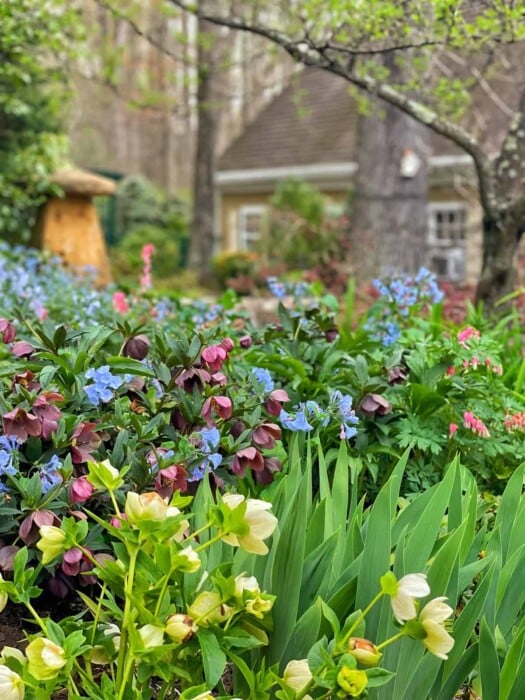Learn how to grow enchanting bleeding hearts (dicentra) in your shade garden! This guide covers planting, care, and more.
The bleeding heart (Dicentra spectabilis) is a beloved garden classic, prized for its charming heart-shaped flowers that dangle delicately from arching stems. These enchanting blooms, which appear in shades of pink, red, and white, bring a touch of whimsy and elegance to any shade garden. While their bloom time is relatively short, typically lasting from April to June, their unique beauty and graceful foliage make them a favorite among gardeners. Learn how to grow bleeding hearts with these simple tips.
(Posts on stacyling.com may contain affiliate links. Click HERE for full disclosure.)

About Bleeding Hearts (Dicentra Spectabilis)
Bleeding hearts are native to Asia and North America, and they thrive in USDA hardiness zones 3-9, meaning they can tolerate a wide range of temperatures. Depending on the cultivar, they typically grow 1 to 3 feet tall and wide, forming attractive mounds of foliage. Their leaves are fern-like and often have a bluish-green tint, adding to their visual appeal even when not in bloom.
Growing Conditions For Bleeding Hearts
To ensure your bleeding hearts flourish, it’s important to provide them with conditions that mimic their native woodland habitat.
- Light: Bleeding hearts prefer partial shade to full shade. In hotter climates, providing more shade is crucial to prevent the delicate foliage from scorching. My dicentra plants have performed best under trees so they can get that dappled light.
- Soil: The ideal soil for bleeding hearts is moist, well-drained, and rich in organic matter. This type of soil provides the necessary nutrients and moisture retention while preventing the roots from becoming waterlogged. It’s a good idea to test your soil before planting to ensure they have a good foundation for healthy growth. Dicentra prefers a slightly acidic to neutral soil pH. This generally falls within the range of 6.0 to 7.5.
- Watering: Consistent moisture is key, especially during dry spells. However, be careful not to overwater, as this can lead to root rot. Strike a balance and aim to keep the soil evenly moist but not soggy.
- Fertilizing: While some recommend a balanced fertilizer applied in early spring to provide the necessary nutrients for healthy growth and abundant blooms, I recommend focusing more on providing good quality soil with lots of organic matter.

Bleeding Hearts: Planting and Care
- Planting: The best times to plant bleeding hearts are in the spring or fall. When planting, space them according to their mature size, typically 1 to 3 feet apart depending on the variety, to allow for adequate air circulation and growth.
- Mulching: Applying a layer of organic mulch, such as shredded bark or leaf compost, around the plants offers multiple benefits. It helps retain soil moisture, suppresses weed growth, and keeps the soil cool during the summer months.
- Support: Taller varieties of bleeding hearts may require staking to prevent their delicate stems from flopping over, especially in windy conditions. Staking helps maintain the plant’s shape and prevents damage to the flowers. For more information about supporting tall flowers, read this post.

Common Dicentra Pests and Diseases
Bleeding hearts are generally resilient and resistant to most pests and diseases. However, it’s still a good practice to monitor them for potential issues.
- Common Pests: Aphids, slugs, and snails are occasional pests that can affect bleeding hearts. Aphids can be controlled with insecticidal soap or by introducing beneficial insects like ladybugs. Slugs and snails can be managed with traps or barriers. I like to use this granule to help manage slug and snail issues.
- Common Diseases: Leaf spot and fungal diseases can sometimes occur, especially if the plants are grown in overly wet or humid conditions. Ensuring good air circulation and avoiding overhead watering can help prevent these issues. If diseases do appear, treat them with an appropriate fungicide.
Dividing Bleeding Hearts
Dividing established clumps of bleeding hearts is beneficial for maintaining their vigor and health. It also allows you to propagate new plants to expand your garden or share with friends.
- When to Divide: The ideal times to divide bleeding hearts are in early spring, just as new growth emerges, or in the fall after the foliage has died back.
- How to Divide: Carefully dig up the entire plant and gently divide the crown into sections. Make sure each section has a good portion of healthy roots and shoots.
- Replanting: Replant the divisions at the same depth they were originally growing, water them thoroughly, and add a layer of mulch to help retain moisture.
For more information about how to divide your bleeding hearts, please read this article on dividing perennials.

Growing Bleeding Hearts in Pots
Bleeding hearts can be successfully grown in containers, making them a versatile choice for patios, balconies, or even indoors with sufficient light.
- Container Selection: Choose a pot that is at least 12 inches in diameter and has drainage holes to prevent waterlogging. The pot size should accommodate the mature size of the plant.
- Potting Mix: Use a well-draining potting mix that is rich in organic matter. This type of mix provides good aeration and moisture retention for optimal root growth.
- Watering: Container-grown bleeding hearts require more frequent watering than those planted in the ground, as the soil tends to dry out faster. Water thoroughly whenever the top inch of soil feels dry to the touch.
- Fertilizing: Since container plants have limited access to nutrients, they benefit from more frequent fertilization. Use a balanced liquid fertilizer every few weeks during the growing season.

Dealing with Foliage Dieback
One unique characteristic of bleeding hearts is their tendency to go dormant in the heat of summer, especially in warmer climates. This means their foliage will yellow and die back, leaving a gap in your garden. However, there are ways to manage this and maintain a visually appealing garden bed.
This dormancy is a natural process for bleeding hearts, allowing them to conserve energy and survive the summer heat. It’s important to remember that the plant is not dead; it’s simply resting.
Concealing the Gap
- Companion Planting: One effective strategy is to interplant bleeding hearts with later-emerging perennials that will fill in the space as the bleeding heart foliage fades. Good choices include hostas, ferns, and astilbes, which will provide continued interest and cover the bare area.
- Strategic Placement: Planting dicentra spectabilis behind other plants that will grow taller and mask the dying foliage is another way to address the issue. Consider placing them behind shrubs, taller perennials, or ornamental grasses.
- Groundcovers: Low-growing groundcovers, such as creeping phlox or lamium, can effectively cover the bare soil around the base of the plant as the foliage dies back.
- Annuals: Filling in the gaps with colorful annuals is a great way to maintain continuous summer interest in the garden bed. Choose annuals that thrive in similar light conditions as bleeding hearts.

Final Thoughts About Growing Bleeding Hearts in Your Shade Garden
Bleeding hearts are a delightful addition to any shade garden, bringing a touch of spring magic with their unique and beautiful flowers. By following these tips and providing the right growing conditions, you can enjoy these charming plants for years to come. So, why not add a few bleeding hearts to your garden?
I hope you found this article helpful and inspiring. Are you currently growing Dicentra? If not, will you be adding it to your shade garden this year?
For more information about growing bleeding hearts, please read this article from the Cornell University Cooperative Extension.
To drill down on more beginner gardening techniques and tips, please read these posts:
- Flower Gardening 101
- Growing a Cut Flower Garden for Beginners
- Container Garden Ideas for Beginners
- How to Start a Vegetable Garden
- Herb Gardening for Beginners
Thank you for visiting the blog today!
Enjoy your day! xo







